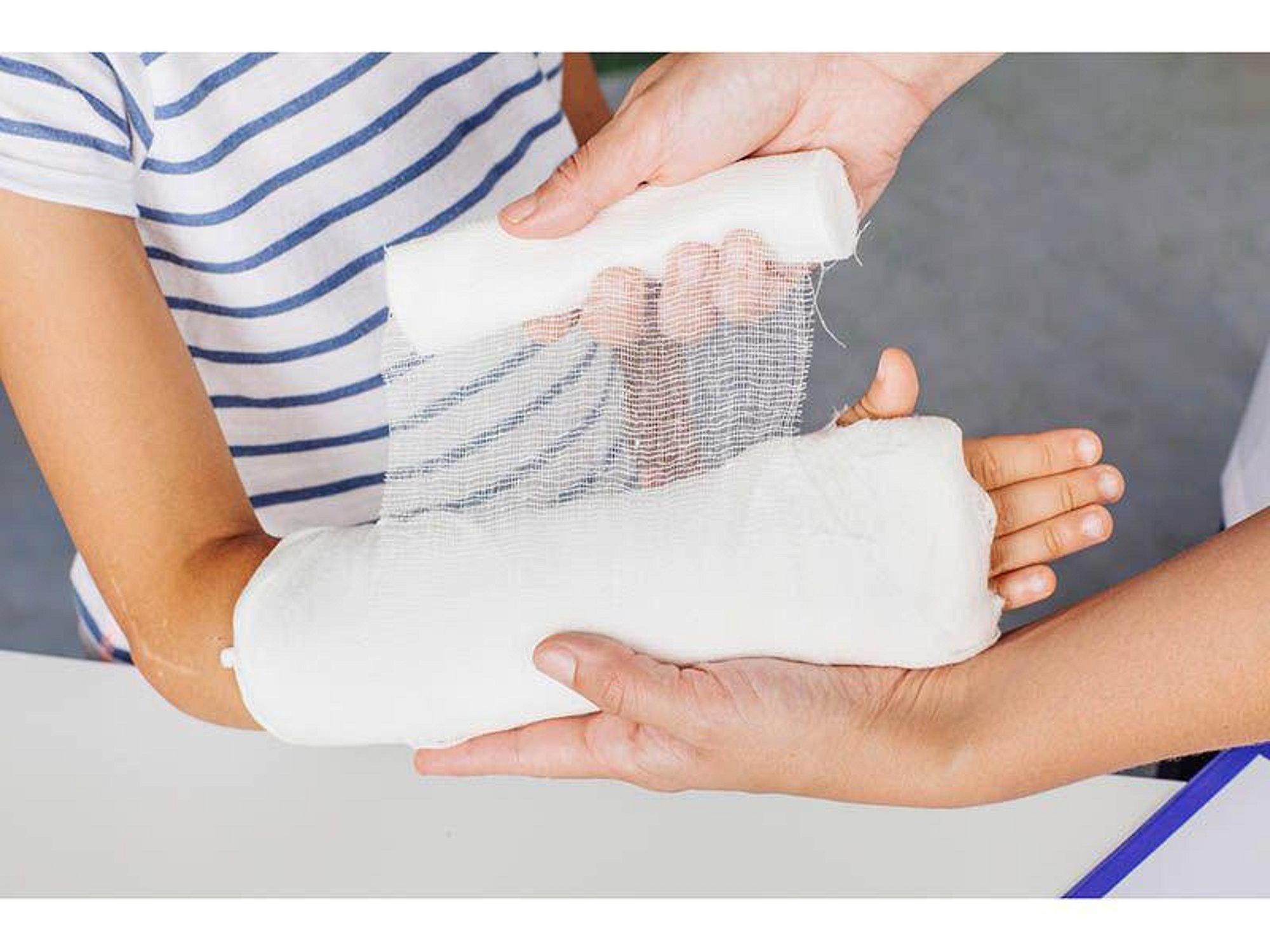Broken Bones

Any bone in the body can break under enough stress. You should be alert for the possibility of broken bones anytime someone suffers a serious blow, perhaps in a fall, a car accident, or a high-speed wipeout on a bicycle. For people whose bones are weakened by osteoporosis, it can take only a slight tumble to cause a fracture. In fact, more than 1.5 million osteoporosis-related fractures are estimated to occur every year.
Broken bones usually aren't a life-threatening emergency, but they can be extremely painful. Prompt first aid can comfort a victim while preventing further damage.
What to look for
Broken bones tend to cause swelling, bruising, and possibly bleeding. Sometimes a victim may report having heard a snap or a cracking sound as the bone broke. Although most broken bones cause intense pain, it's possible for a victim to feel no pain at all immediately following a break. If there's a break in the leg or arm, the victim may be unable or unwilling to move part of the limb. But that's not always the case. Sometimes a person can move or even put weight on a broken or cracked limb, but not feel pain.
Although all broken bones require prompt medical attention, some cases are particularly serious. Call 911 emergency help if you notice any of the following:
- The victim is bleeding heavily.
- The bone pierces the skin. (This is called a compound or open fracture.)
- The victim has fallen from a great height.
- You suspect a broken bone in the head, neck, back, hip, pelvis, or upper leg.
Take the victim to the emergency room if you notice these signs:
- Gentle movement or light pressure causes pain.
- A limb or joint is misshapen.
- Toes or fingers below the injury turn blue at the tips.
What to do
After a serious accident, tending to broken bones may not be the first priority. Check to make sure the victim is breathing. If not, call 911 and begin performing cardiopulmonary resuscitation (CPR).
Next, check for open wounds or other injuries that might require immediate attention. You should also watch for short or faint breaths, a possible sign of shock. If the victim goes into shock, position him with his head a little bit lower than his trunk and wrap him in a coat or blanket.
If you suspect that there may be an injury to the spine, do not move the person unless there is an immediate, life-threatening danger. Call 911. Keep the head and neck stable by placing your hands on both sides of the injured person's head, keeping it in line with the spine and preventing movement. Continue to hold the head still and in alignment until medical help arrives.
If the person is vomiting, roll the head, neck, and body over as one unit (the "log roll") to prevent choking and protect the spine. You'll need two people: one stationed at the head, the other at the victim's side. Keep the person's head, neck, and back in line with each other while you roll him or her onto one side.
Ideally, you won't have to do anything else until help arrives. If there is an open wound at the break, do not attempt to clean it. But if the victim has a broken bone in her arm or lower leg and you must move her before help arrives, stabilize the area above and below the injury with a splint. To make a splint for the lower arm, place a rolled-up newspaper or folded piece of clothing under the arm and tie it up with strips of cloth or rope. If possible, fashion a sling with a shirt or other piece of cloth to keep the arm still. To splint a lower leg or ankle, wrap the injury in bulky clothing and tie it with strips of cloth or rope.
If possible, apply an ice pack or some other cold object to reduce pain and swelling.
In most cases, you should NOT try to realign a limb that is out of place. However, if the victim is starting to feel numbness or tingling below the injury or if skin below the injury is starting to turn pale or blue, the injury may be cutting off circulation. A realignment could be both painful and risky. If it's possible, get emergency medical advice before trying to move the limb into its normal position.
References
National Institutes of Health. Medical Encyclopedia: Broken bone. http://www.nlm.nih.gov/medlineplus/ency/article/000001.htm
National Institutes of Health. Medical Encyclopedia: Head injury. http://www.nlm.nih.gov/medlineplus/ency/article/000028.htm
National Institutes of Health. Medical Encyclopedia: Spinal/neck injury. http://www.nlm.nih.gov/medlineplus/ency/article/000029.htm
Mayo Clinic. Fractures (broken bones). http://www.mayoclinic.com/invoke.cfm?objectid=5B479591-E2C6-4544-A910E7A9CC2B2765
The Harvard Medical School Family Health Guide. Broken Bones. http://www.health.harvard.edu/fhg/firstaid/broken.shtml
American Academy of Orthopaedic Surgeons. Fractures. http://orthoinfo.aaos.org/fact/thr_report.cfm?Thread_ID=125&topcategory=General%20Information
American Academy of Orthopaedic Surgeons. Fractures: What bones are made of.http://orthoinfo.aaos.org/brochure/thr_report.cfm?Thread_ID=9&topcategory=General%20Information
Mayo Clinic. Head Trauma. http://www.mayoclinic.com/invoke.cfm?objectid=4425997E-0F78-49B0-B8CCFEA3F3AAF219
National Osteoporosis Foundation. Fast facts on osteoporosis. http://www.nof.org/awareness2/images/Fast_Facts.pdf
Related Posts
New York State Lifts Indoor Mask Mandate
THURSDAY, Feb. 10, 2022 (HealthDay News) -- An indoor mask mandate in New York...
Survival Advantage Seen for A+ADV in Advanced Hodgkin Lymphoma
THURSDAY, July 14, 2022 (HealthDay News) -- For patients with stage III or IV...
Los antibióticos pierden su poder contra unas infecciones sanguíneas letales de los recién nacidos
LUNES, 12 de junio de 2023 (HealthDay News) -- Alrededor de todo el mundo, están...
¿Se arrepiente de haberse tatuado? Consejos para quitarse la ‘tinta’ vieja
DOMINGO, 6 de agosto de 2023 (HealthDay News) -- Ya sea que se hiciera un...
